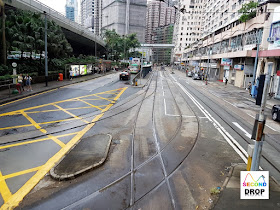About the Ding Ding
The Ding Ding, known officially as Hong Kong Tramways, first opened in 1904 and comprises a single track that ran from Kennedy Town to Causeway Bay. Today, the system has been upgraded to a double track system and runs pretty much the entire length of Hong Kong island from Kennedy Town to Shau Kei Wan. It was the main form of public transport on Hong Kong island until the Island Line MTR opened in 1985.
My Experience
I took the Ding Ding along its original section. I started off at Kennedy Town Terminus all the way to O'Brien Road station, which is beside Wan Chai MTR station. It was a Saturday evening so there was quite a lot of passengers, though there were still seats available. Single trip fare is HKD 2.30 regardless of distance, and you should only flash your octopus card when you EXIT!
Before I got on, I walked around reversing loop at Kennedy Town Terminus. Basically, the so called terminus is only a single stop. To turn around, the streetcars will follow the track which circles around a building along the road. As such, no need for an expensive streetcar interchange!
 |
| All aboard! |
 |
| My favourite seats! At the front of the Ding Ding on the upper deck! |
I feel tempted to say that this slower ride makes me appreciate the slower pace of life in old Hong Kong, but then I realised that Hong Kong at that time was already a major trading hub of the British Empire. So I guess for people of that time it was considered a very fast paced city already.
 |
| A complicated mess of track near HK Macau Ferry Terminal |
 |
| Now this is a sweet feature. Signs on top of the station so upper deck passengers can see where they are at. |
Star Ferry
After alighting at Wan Chai, I headed straight to Wan Chai Ferry Terminal, one of three Ferry Terminals served by the traditional green ferries. The other two ferry terminals are at Central and Tsim Sha Tsui, which is where I was headed. But first, a 15 minute walk around the super confusing Wan Chai Convention Center and past the tourist time waster called Golden Bauhinia Square.
 |
| See? A tourist time waster. Brings back memories of myself standing there doing nothing. |
 |
| HOW MUCH MORE DO I HAVE TO WALK!? |
Just like the Ding Ding, the Star Ferry Boats are over 100 years old. In fact, the green boats date back to 1888. The oldest boat in service now is the Celestial Star, which was launched in 1956. A typical Star Ferry boat seats 576 passengers. It is popular among commuters because it is one of the cheapest ways to cross the harbour, with prices at HKD 2.70 (weekdays) and HKD 3.70 (weekend and Public Holiday)
The ferry terminal is actually fairly modern and well equipped. There are toilets, a seated waiting area and electronic signs telling you the next departure. Boats generally depart at 6-12 minute intervals and run from 6.30am to 11.30pm.
 |
| HA HA HA! |
 |
| To facilitate quick boarding, Star Ferry uses wide boarding ramps. I actually thought those were vehicle ramps! |
The interior of the ferry is made of row upon row of bench seats. There are 3 main compartments: fore, middle and aft. I do not have any recommendations about which compartment is better - just take the window seats! If the ferry is crowded, the lower deck can also be open for passengers.
 |
| OMG! Is this a World War 2 US navy briefing room? |
For me, I think the ferry ride offers the best views of Victoria Harbour. When you are riding in this old, fifty year old boats across one of the most modern cities in the world, you can really appreciate how the past and the present of Hong Kong are interacting with one another. I dare say that you may even feel like being a part of history. A history that is still being relived by thousands of commuters each day.
 |
| We passed by a modern ferry. The modern ferry is faster, but it cannot match the feeling of nostalgia that you get riding the old Star Ferry boats. |
 |
| The view of the harbour from the Ferry |
 |
| erm...I just can't pass a good photo opp, right? |
The Verdict
The Ding Ding and Star Ferry are really must-sees. As modern city dwellers, we often forget about our past and how it shapes our lives today. However, the Ding Ding and Star Ferry are two historic systems that still continue to shape the lives of Hong Kong residents. I mean, in most other places, historic transport is usually downgraded to just a small tourist service. However, the Hong Kong Tramways and Star Ferry are still going strong.
Even if you are not into history, I still think it is worth a ride because it really allows you to see the city in a new light. Not to mention, the tickets are a bargain.
If you like Hong Kong, why not check out these other activities














